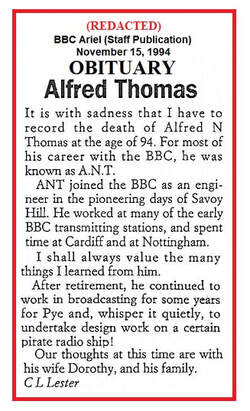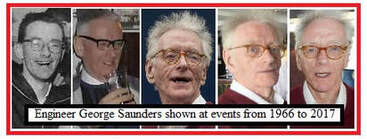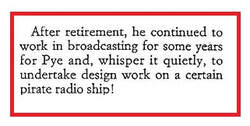|
Prince Charles explains 'pebble theatre'.
|
PEBBLE
|
|
Don Pierson [right] explains how a young Prince Charles made a request to join the Radio London fan club. |
|
|
Prince Charles explains 'pebble theatre'.
|
PEBBLE
|
|
Don Pierson [right] explains how a young Prince Charles made a request to join the Radio London fan club. |
|
|
It is unfortunate that the world of media has linked its output to the action world of Marvel comics where everything can be explained quickly and within a few frames. But real life is not like that. Paul Rusling on the other hand, lives in the comic book world where it is possible to hammer round pegs into square holes. It is that same kind of simplistic world where a "mild mannered" newspaper reporter can step into a phone booth (kids now ask: "What is that?") where he puts on male underwear over a skin-tight body suit, and then drapes his shoulders in a cloak. The result is Superman who can solve all the complex problems of the world. In reality it is the slow plodding that reveals the real story, and the quick glance reveals nothing but jibber-jabber mixed with gobbledygook. But when paying customers are conned they often keep quiet for fear of looking foolish. When it is revealed that the promise on the cover is not supported by the contents, a lot of conned victims keep quiet, and so the con goes on. If you are looking for a quick explanation about the start of Radio Caroline: forget it, you won't find it here! What you will find is a detailed explanation such as the one you might find in a real court room where the evidence is presented in sequence after a foundation for its admission has already been laid down by the preceding evidence. I have now explained what happened on page 276 of 'Radio Man' and why that lone paragraph was created. I have also revealed who created it, and now it is time to examine the reasons why it was created in a more specific manner than just pointing out the differences between the words entity and identity. This is where it became very tedious and boring for anyone looking for a quick answer. The answer really was in the details, and those details began by looking for an existing company that could be described as a ".... company manufacturing radio equipment ....". But this is not necessarily a company manufacturing radio broadcasting equipment. Another clue: This existing company manufacturing radio equipment is not necessarily emblazoned with the 'Pye' logo front and center. It may appear somewhere, but it is not something that consumers, or broadcasting listeners would be on the lookout for. It could be a specialist company that stands on its own merits and has a self-sustaining name that means something to its customers.  Furthermore, this company, being an existing entity, is to be given (according to Alan Bednall), an additional identity, but nothing that would link it directly to an offshore broadcasting ship. Then there is the question of a time period. When, what month of what year are we talking about? If all this sounds rather vague, remember what else Alan Bednall said: "It was to be many years before anyone outside the Board Room knew that Pye had supplied all of the broadcasting equipment for Radio Caroline (as well as Manx Radio, Lourenco Marques Radio, and Radio Luxembourg)." Some, reading the comments about 'Manx Radio', assume that what is being referred to is the caravan of equipment that became the first home of Manx Radio. But there was a lot more going on than just Manx Radio, which was described by John Stanley as a station operating on "flea power" because of the limitations imposed by its British General Post Office licence. However, there was also a rival, but not-operational project called 'Radio Vannin' that was waiting in the wings, and its status was tied to the future of Radio Caroline which had just begun broadcasting from off the Essex coast. Behind all of the various news stories about broadcasting on the Isle of Man was John Stanley, and his father Charles Orr Stanley. However, outside of the Pye Group board of directors who knew knew about this this cat and mouse game that the Stanleys were playing with the British Crown? Now keep in mind that what Alan Bednall claimed. It was that Pye had supplied the equipment for all of their nefarious plans, but Bednall did not say that Pye had manufactured any of it! So, if Pye ran this entire scheme as a clandestine and top secret "need-to-know" military-type of operation, how did 'The Trio' stumble across the new identity of this existing company so many years later? Furthermore, if this new identity was not even publicized, how did this riddle get solved? The answer is good old fashioned detective work! That means painstaking hours spent slogging away looking for a needle-in-a-haystack that its creators did not want anyone to find. But like all "perfect crimes", there is always a clue to be found because perfection is not really achievable. Somewhere, some element is always overlooked. It was either always there before the event, or it is something that happened during the event that got overlooked, or it is a combination of both of those factors. Once the clue has been uncovered, then various other pieces of evidence become self-evident, and quite often, and in this instance, that is exactly what happened. The clue to this mystery is an obscure obituary that was published in 1994, and it focused attention on the Pye Group of companies.  This Obituary notice refers to the death of Alfred Nicholas Thomas, and it came to the attention of 'The Trio' courtesy of George Saunders. He was at one time the Chief Transmitter Engineer on board the mv Mi Amigo, and that was beginning with the years when that ship was still the home of 'Radio Atlanta'. George Saunders has had a long and interesting career that stretches back in time. It began with Marconi; continued with Radio Atlanta and Radio Caroline South, and for a short period of time on Radio Caroline North to sort out its transmission problems; then with H.M. Government for work directed towards Ian Smith's self-declared State of Rhodesia, and finally his career concluded after years of employment with BBC-Television in Wales. George Saunders also has a passion for studying the clandestine world of British broadcasting history that runs parallel to, but "under-the-radar" of official BBC history. That hidden history disproves the popular belief that the BBC has held a monopoly on all official broadcasting activity by transmitters located both within, and external to, the United Kingdom.  George Saunders (shown right), was provisionally hired in 1964 by John Howard Gilman, a former BBC engineer who worked with Alfred Nicholas Thomas. The initial approach to George Saunders was made in a pub, just after George Saunders got off work from Marconi. Retired BBC engineer John Howard Gilman approached Saunders in a very casual manner, but when George reconsidered this event retrospectively, it took on the appearance of a staged confrontation since Gilman did not regularly frequent that pub, and he did not live anywhere near it. This inferred planning and selectivity based upon prior screening. George now thinks that he had been ear-marked for the job, but before he was approved, he had to undergo a second interview. Gilman was extremely knowledgeable about radio antennas, whereas Alfred Nicholas Thomas was extremely knowledgeable about transmitters. When he retired from the BBC in 1959, Thomas had a reputation that did not endear him to his co-workers, but he was respected by them for his knowledge. Behind his back everyone called Thomas "Ant", but to his face everyone called him "Sir!", and very few liked him as a human being. During Saunder's secondary interview and scrutiny by Alfred N. Thomas, George Saunders claimed that he had to endure one of the most grueling technical interviews during his career as an engineer. George Saunders has spent many years researching and reading about the 'alternative' and clandestine British radio service that operated parallel to the BBC. This led Saunders to become more than casually interested in the career of John Howard Gilman, because just as WWII was drawing to a close, Gilman accompanied by fellow British troops, took charge of the powerful Nazi transmitter over which 'Lord Haw Haw' had broadcast to Britain. Gilman became Saunders boss as administrator of the technical side of Radio Caroline broadcasts from both of its ships. From time-to-time Saunders also stood in for Gilman at Caroline House on Chesterfield Gardens. Because George Saunders has shared his knowledge base with 'The Trio', they learned that Gilman was in charge of more than the technical side of the Caroline operation, and for a time he also cropped up as a director of the company that employed the djs! George has shared book lists; various publications; documents such as the Obituary of Alfred Nicholas Thomas, and a lot of first-hand background information.  George Saunders was aware that A. N. Thomas had been associated with an offshore project called GBOK. However, some aspects of George's GBOK information are clearly apocryphal and originated from hearsay within the Marconi-BBC broadcasting community. But surprisingly, the one line that George Saunders had overlooked was this one: "After retirement, he continue to work in broadcasting for some years for Pye ..." That revelation is followed by this line: "... and whisper it quietly, to undertake design work on a certain pirate radio ship!" We do know that Alfred Nicholas Thomas was also in at the planning stage of Radio Caroline, before a mast, let alone the antenna, was even attached to it. The same goes for the creation of Radio Atlanta, and both of those early discussions took place in the office/studio of Allan Crawford located at 47 Dean Street where the early Radio Caroline programs were taped. A number of people were present at that documented event in which Thomas discussed the mast to be attached to the mv Fredericia, and one of them was Ronan O'Rahilly. That is because Radio Caroline and Radio Atlanta were planned simultaneously, although Radio Caroline was of special interest to Pye, and that interest stretched back to GBOK, but so. did the technical interests of Alfred Nicholas Thomas.  Because of bad management the GBOK venture crashed before it began. But GBOK also had several things going for it. Pye was assisting GBOK as part of its long range plan to stimulate interest in order to force the introduction of licensed sponsored commercial radio in the United Kingdom. The offshore plan at this stage was to assist the nearly 200 stations that were waiting for licences. Pye was working with the GBOK project via the obfuscated company mentioned by Bednall and it was enploying Thomas and Gilman to manage the project. But all the pieces of the puzzle had not as yet come together. Pye did not have the benefit of offshore shipping know-how acquired by Brown and Root who were behind the REM Island project; nor did they have the legal expertise of Dr Peter Maxer of Liechenstein who was the European architect of international tax evasion.. But GBOK did have a valuable advertising contract for 'The World Tomorrow' radio program, and contact with the CIA 'asset' who was responsible for placing American religious programs on stations around the world. However, there was one addition that they could have done without. That was Allan Crawford who was on a quest to secure the lease of the former 'Radio Nord' ship renamed 'Magda Maria' in order to promote his own cut-price record labels. But his plans clashed with the short term plans of Charles Orr Stanley and John Stanley; although Crawford was able to link the Texan-Liechtenstein expertise which had developed as a result of the former Radio Nord project. On top of all that, but compounding the problems facing Pye, there was a con man named Arnold Swanson, and he was the person fronting GBOK. But Charles Orr and his son John Stanley had been working on a plan to introduce licensed sponsored commercial radio since the 1940s, and they were not about to stop. It was at this point in the story that Pye began to bring all of the pieces together, coupled with new information from Texas. Thus, somewhere during September to October 1963, the idea for Radio Caroline was born. In his actual statement made for Nicholas Stanley about Radio Caroline, Alan Bednall said that: "... Pye were determined to support and were determined to see should succeed." This blog theme will be continued tomorrow with the history of GBOK and Arnold Swanson who was the person who appeared to be fronting it. I will also explain the precursory details that led to the creation of Radio Caroline. At this point 'The Trio' wish to acknowledge the assistance they have received from certain people who have assisted with this research project. Some of this material has been previously shared via the former 'Caroline Investigation' newsletter. It was that publication which Paul Rusling had access to and incorporated into his book in order to promote the false idea that original Radio Caroline is still on the air, or that the people currently using that name have some connection to the operation that took place between 1964 and 1967. Because this blog has generated a certain amount of hate mail from those individuals who are perpetuating that fraud, 'The Trio' wish to make it clear that they are assisting this blog because it provides a public service in the public interest. No money has been solicited from anyone other than from 'The Trio' themselves. UPDATE: Since I first put this new edition of the blog online today, I have had a chance to proof-check my own work, and thus I have corrected a few typographical mistakes.
0 Comments
Your comment will be posted after it is approved.
Leave a Reply. |
Our team produced this free radio program for PCRL in Birmingham.
It was repeatedly broadcast on and after October 20, 1985. Click & listen! Blog Archive
August 2023
Copyright 2021 with all rights reserved.
|
Index |
Library |
|
